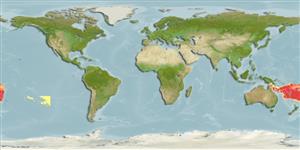Klassifizierung / Names
Namen | Synonyme | Catalog of Fishes(Gattung, Arten) | ITIS | CoL | WoRMS | Cloffa
>
Gadiformes (Cods) >
Macrouridae (Grenadiers or rattails)
Etymology: Hymenocephalus: Named for its transparent membrane-like head covering (‘‘hymen head’’) and fragile nature of head bones (Ref. 100825).
More on authors: Merrett & Iwamoto.
Environment: milieu / climate zone / depth range / distribution range
Ökologie
seewasser bathypelagisch; tiefenbereich 919 - 1000 m (Ref. 98298). Deep-water
Western Central Pacific: Vanuatu; also recorded from New Caledonia (Ref. 86942).
Size / Gewicht / Alter
Maturity: Lm ? range ? - ? cm
Max length : 14.3 cm TL Männchen/unbestimmt; (Ref. 98298)
Kurzbeschreibung
Morphologie | Morphometrie
This species is distinguished by the following characters: pelvic fin rays 13-14; pectoral fin rays 13-15; projecting snout 25-30% HL; no barbel; small orbit diameter 25% HL; interorbital width 55% HW; infraorbital width 16-17% HL; preopercular supporter is moderately long and straight, 6% HL; gill rakers 25-26; ventral striae reaching to about ? from pelvic fin bases to periproct; small otolith with rounded outline, no predorsal lobe developed, colliculi separated and reaching close to anterior and posterior rims of otolith; otolith length to height (OL:OH), 1.05; total colliculum length to pseudocolliculum length (TCL:PCL), 2.8 (Ref. 98298).
Life cycle and mating behavior
Geschlechtsreife | Fortpflanzung | Ablaichen | Eier | Fecundity | Larven
Schwarzhans, W., 2014. Head and otolith morphology of the genera Hymenocephalus, Hymenogadus and Spicomacrurus (Macrouridae), with the description of three new species. Zootaxa 3888(1):1-73. (Ref. 98298)
IUCN Rote Liste Status (Ref. 130435)
Bedrohung für Menschen
Harmless
Nutzung durch Menschen
Mehr Information
NamenSynonymeMetabolismusRäuberÖkotoxikologieFortpflanzungGeschlechtsreifeAblaichenSpawning aggregationFecundityEierEientwicklung
Alter/GrößeWachstumLänge-GewichtLänge-LängeLängenhäufigkeitenMorphometrieMorphologieLarvenLarven Pop.Dyn.RekrutierungDichteBRUVS
ReferenzenAquakulturAquakultur ProfilZuchtlinienGenetikElectrophoresesVererbbarkeitKrankheitenVerarbeitungNutrientsMass conversion
PartnerBilderStamps, Coins Misc.LauteCiguateraGeschwindigkeitSchwimmstilKiemenoberflächeOtolithsGehirngrößeSehfähigkeit
Tools
Zusatzinformationen
Download XML
Internet Quellen
Estimates based on models
Preferred temperature (Ref.
123201): 3.1 - 3.7, mean 3.4 °C (based on 6 cells).
Phylogenetic diversity index (Ref.
82804): PD
50 = 0.5000 [Uniqueness, from 0.5 = low to 2.0 = high].
Bayesian length-weight: a=0.00219 (0.00111 - 0.00431), b=3.20 (3.03 - 3.37), in cm total length, based on LWR estimates for this (Sub)family-body shape (Ref.
93245).
Trophic level (Ref.
69278): 3.3 ±0.4 se; based on size and trophs of closest relatives
Widerstandsfähigkeit (Ref.
120179): mittel, Verdopplung der Population dauert 1,4 - 4,4 Jahre. (Preliminary K or Fecundity.).
Fishing Vulnerability (Ref.
59153): Low vulnerability (10 of 100).
